Kim McBrien Evans interview by Michelle Lee
May 8, 2020
As part of the Spring 2020 Current Threads online exhibit, Impervious by Kim McBrien Evans is one of Kim’s custom shawl designs using her custom dyed yarns. Kim owns Indigodragonfly Studio in Ontario, Canada. SDA board member Michelle Lee interviewed Kim via email to find out more about her life, design process, and new book coming out this fall.
1) How do you find your inspiration? Is there a special place, music, book, or person that has inspired you, and what did you create from that inspiration?
For me, inspiration can come from anywhere. People in my life. Landscapes of places I love like the city of Toronto or Haliburton or the east coast. I believe that what we create is in and around us all the time. Ideas can come from scribbles in my sketchbook, something in the news that saddens or enrages me, taking a walk and looking at the ground…it’s EVERYWHERE! One small thing will dominate my attention until I make it into something.
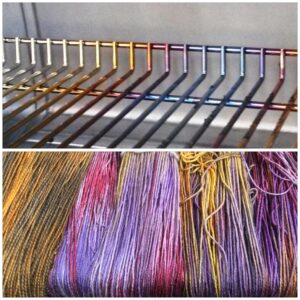
A new BBQ fired up for the first time inspired another.
2) What inspired you for the Impervious shawl? How did you decide on the name Impervious? Did the Crouching Dory Hidden Nemo colourway come before or after the shawl pattern?
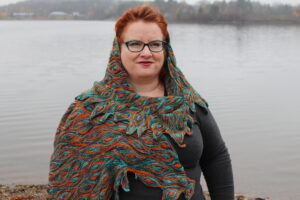
Impervious is the second piece in the Optical Delusion series.
The Impervious shawl is the result of 12 years of experimenting with short rows and improvised knitting. This technique, with its flame/leaf/wave shapes strung together organically is one I could play with forever and never get bored of seeing where it will go I did want to write a pattern with this technique, and that—the act of writing it down in words and knitting code—was the most difficult part. While there is a small number knitters out there that would be comfortable with instructions that say “cast on x sts; knit back and forth until it looks like this; keep going until you have a thing”, most want to know exactly what to do to get exactly that thing they see in front of them. Learning how to take a visual form and translate it was what was time consuming. The name Crouching Dory, Hidden Nemo, like all our colour names, is my partner Ron’s fault. He has a great, creative, twisted brain that plays with words in ways that are fun and clever. We like to say his degree is in journalism, so of course now he’s a colour-namer for a yarn brand.
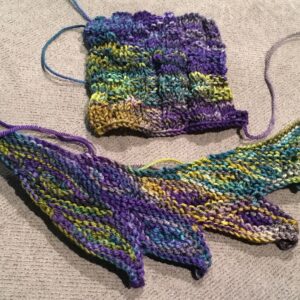
Experimenting with how different colour and dyeing techniques work with this short row form.
The colourway was intentionally dyed with two ideas in mind: fire, and mid-century modern textiles. In an effort to move away from colours I usually play with, I started collecting images in other colour palettes to change the input my brain is used to. Each of the 3 main colours is actually layers of 3 or 4 colours to give depth and dimension and movement in the yarn before I started knitting. I wanted the finished shawl to look and feel like fire and those layers accomplish that. When it’s wrapped around me, I’m engulfed in flames. But the shawl makes me feel fireproof. When I name a pattern, I give it a name that reflects what it represents or how I want to feel when I’m wearing it. Impervious says it all in one simple word.
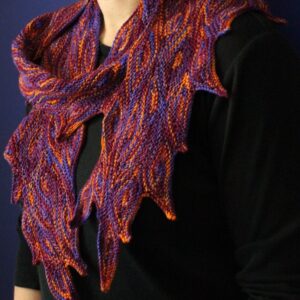
Conflagration was the first piece using this technique.
When others try it on, I can see their posture change, their faces change. They are transformed. And that’s what I want my wearables to do: transform the wearer.
3) You own Indigodragonfly yarn studio. What drew you to working with/dyeing yarn as a business?
The short answer: the yarn I had pictured in my mind didn’t exist yet, so I needed to make it. And so I did. The long answer: I have played in textiles my entire life. Knitting was one of my first techniques, and the one I keep going back to. Shortly after losing my arts administration job in 2009, members of my knitting community, both in person and online, encouraged me to start a yarn dyeing business. I had been dyeing yarn for myself because I wasn’t finding yarns that were “just right”, so I made them for myself. Through this encouragement, I started Indigodragonfly and was joined by my partner Ron shortly after he lost his job in the same year. We haven’t looked back.
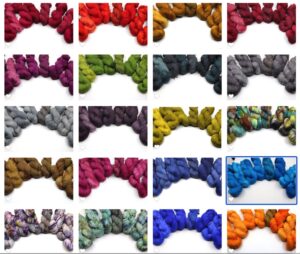
A sample of Indigodragonfly’s regular colour palette.
Now what I crave from dyeing is seeing how far I can take it. How many ways can I take the same material and the same basic, out of the box dye colours and change them? I run the Stained Fingers Dye Camp (for adults) at our studio every summer, and the students that come back year after year push me to keep experimenting, to find new tools and techniques, and to be willing to try everything I ask them to. When it’s me and the pot, I play and experiment with layers of colour until the effect is just what I’ve imagined, or until it’s something I didn’t even know existed inside me. It’s very revealing, creating colour from scratch.
4) How do you design your colourway combinations? The colourway names are fabulous and fun. Do you have a favorite one and is there a story behind the name?
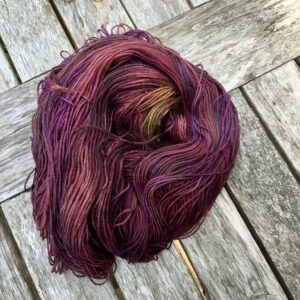
I’ve been told that my yarn colours spill all my feelings out into the world. That they reveal parts of my personality and my emotional life that words can’t. I believe that’s true. The best art…the best craft…is something that tells a whole story in one glance. And maybe that story has no words, but you’re left with the emotions and connection to that piece.
My favourite colourways have layers and layers of colour. I am a knitter. I dye for knitters. I know that I am happiest when yarn changes as it passes through my fingers, so that’s what I’m happiest dyeing.
Sometimes I’m developing a new repeatable colour. Those are generally developed to fill “colour holes” in our palette. That is more mechanical, but even then I look for ways to perfect those colours.
5) What is your creative process from idea concept to finish? Is it different when you create a yarn colourway versus designing a new wearable?
Very spontaneous! The composer Paul Hindemith used to talk about creativity as a lightning bolt: An entire music composition would come into his mind full and complete as a flash of lightning. Then he would unpack it note by note. I find my best ideas come to me in the same way.
For colourways:
There is no output without input. Books, photos, long walks, watching the landscape while driving by, Peeling the layers of bark off a stick and memorizing not only the colours, but the visual texture. Stories. People. Experimenting. I find the less I think about what the dye is doing in the pot and the more I feel my way through, the better the colour. It’s when I try too hard to hit an exact shade that it’s less than.
For wearables: I’m a size 18, 5’0” tall woman. Despite the fact that I am the average dress size in North America, finding clothes in my size that aren’t tents is incredibly difficult. With knitting, we’re creating the fabric stitch by stitch. We have control over every aspect: The shape, the texture, the colour. We can not only create the shape of the garment, but we can also shape our bodies with the clothes we wear.
When designing wearables, I start with the type of garment or accessory I want to wear. Sometimes it starts with scribbles. Sometimes I’ll spend pages in my sketchbook exploring shapes or necklines or sleeve treatments. Then comes the garment itself. My goal is to always make sure that wearables will work on a range of body types. I have croquis I have created on mybodymodel.com using actual measurements from people I know. I start with me, drawing until I NEED to have that garment. Then I “test” different design elements on each one to determine how I need to tweak the pattern to best suit different body types. How deep should the neckline be? Long sleeves or ¾ length? What kind of collar? What should the edges look like? What happens if I move that line a little to the left?
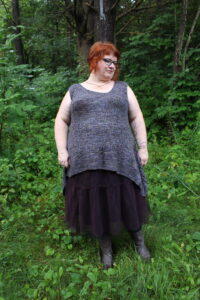
Finished Antiope tunic.
I never truly know if it’s working until the final sample is done. Through the process of hand knitting, I come up with hundreds of ways the garment could be changed, which makes me want to try them all, but the next idea is always poking in me in the shoulder.
6) What did you learn about yourself from working in your upcoming book with Kate Atherley “Custom Shawls for the Curious and Creative Knitter“? How was it to write about ‘breaking the rules’?
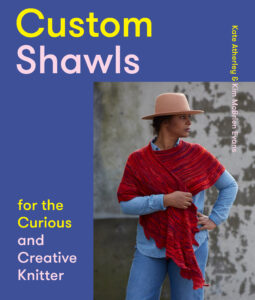
Kate and I have a long-standing collaborative working partnership as designer and tech editor, colleagues and collaborators. This is my first book and Kate’s 7th, so for me it was a very steep learning curve with many moments of being uncomfortable and not feeling smart enough. I found it terrifying to be the first. To create content from nothing, and to put it out into the world. The most important thing I learned through writing about things that have never been written about in detail before, is that everything I know about writing, design and creativity, I developed when I was a child. I went right back to basics and explored the layers of the topics of colour, fabric and creativity with the same attention to detail and sense of exploration as being five years old and peeling apart layers of sticks and leaves.
I’ve rarely followed a recipe or a pattern to the letter. I break the rules on a daily basis and think it’s a very freeing way to live your life. Structure is important. Learning how to stretch and manipulate the structure is better. Kate is the consummate order muppet, overflowing with formulas and spreadsheets and strict forms. I am a self-proclaimed chaos muppet, always looking to see how far I can push boundaries. Working together created a book that has never been created before: one that honours both rules and the breaking of them. And in the end, you’ll see a little of me in Kate’s work, and a little of her in mine.
7) You teach a lot of workshops and are now offer virtual private lessons. If you were to take a workshop, what would you want to study? Is there a specific process, technique, medium or instructor, or maybe something not art-related?
I am at the point in my career where it’s nearly impossible to find a workshop that can give me what I need. I need workshops that push me to be creative in new ways. I need the kind of workshop that will put me in a space for a week and push me beyond my comfort level. I had several such experiences in workshops with Pat Hickman, Hisako Sekijima and John McQueen very early in my career, when I was a basketmaker. I haven’t been able to find the same experiences since.
I want to be pushed. I want to be presented with challenges. I want to be uncomfortable.
8) I saw from your website and IG posts your dogs, Oz and Willow, work at the studio too and Louie the chipmunk is the studio caretaker. What are Oz, Willow and Louie’s favorite yarn weights?
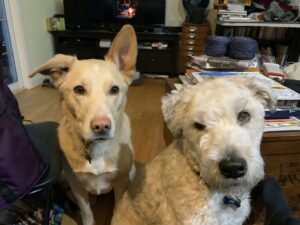
Willow (left) and Oz (right) wonder what I’m knitting.
Louie is a refined chipmunk and prefers a finely spun merino silk lace. Oz is warm, friendly and empathic. He loves a good fingering weight merino. Willow is bouncy, curious and enthusiastic, so her yarn would be an experimental, thick and thin bulky weight.
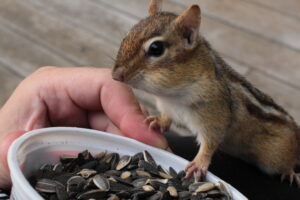
Louie discusses the meaning of life with Ron.

Related Blog Articles
Interview
Learn More: “Textile Narratives, Vintage, Found & Transformed” with Maggy Rozycki Hiltner, Susan Lenz & Jennifer Lee Morrow
Interview
Textile Talk: The Potential of Paper – Audience Questions Answered
Interview
“Artful Conversations: Anita Bracalente” by Catherine Kirsch